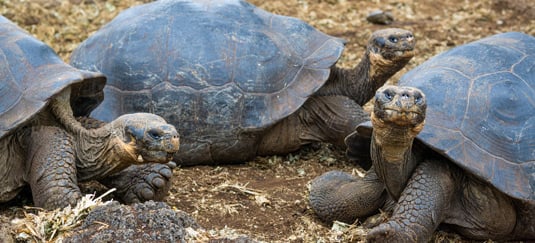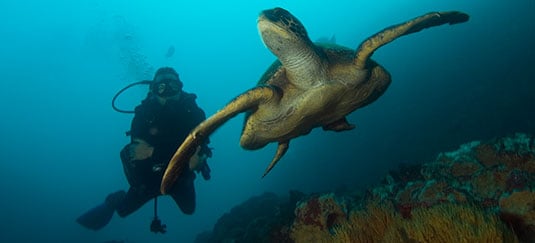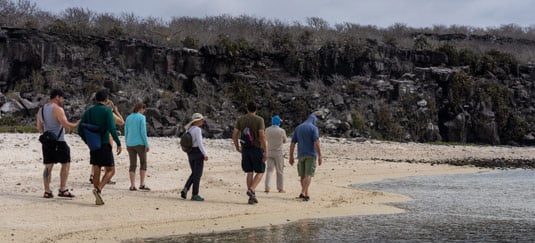Best Time to Visit the Galapagos Islands
The Galapagos Islands offer unique wildlife and activities year-round. The best time to visit Galapagos depends on your interests, whether you’re a wildlife lover, a diving enthusiast, or simply looking for perfect weather.
With two distinct seasons—the Warm, Wet Season (December to June) and the Cool, Dry Season (July to November)—each month brings unique natural wonders to discover.
Galapagos Seasons: Month-by-Month Highlights
Every month in the Galapagos brings unique opportunities to witness nature’s wonders. Whether you’re planning your trip around wildlife encounters, calm seas, or vibrant landscapes, there’s never a wrong time to visit this year-round destination. The key to choosing the best time to go to Galapagos depends on your interests, from snorkeling with playful sea lions to observing iconic species during their courtship rituals.
If you want to know when to visit Galapagos islands to experience seasonal highlights, check out our Galapagos visitor sites map.
The Best Time to Buy Your Galapagos Tour
So you figured out when you want to travel, but when is the best time to buy you Galapagos Islands tour? We have the answers for you right here so you can learn more about the best time for you to buy!
Warm, Wet Season: December to June
If you’re wondering about the best time of year to visit Galapagos, the warm, wet season offers lush landscapes, warmer waters, and incredible wildlife activity. This is an ideal time for snorkeling and diving, with calm seas, excellent visibility, and a vibrant underwater world teeming with life.
| Month | Highlights |
|---|---|
| December | Waved albatross chicks learn to fly, and green sea turtles begin mating. |
| January | Española Island’s land iguanas show vibrant colors, and finches start nesting. |
| February | Penguins return to cooler waters near Isabela, and flamingos and marine iguanas begin nesting near Santa Cruz Island. |
| March | On San Cristobal and Genovesa, frigate birds display their iconic red pouches during mating season |
| April | Blue-footed boobies perform their courtship dances, and giant tortoises finish hatching. |
| May | The transition to the dry season begins, and green sea turtles hatch on pristine beaches. |
| June | A prime time for spotting humpback whales migrating and giant tortoises beginning their mating season. |
Cool, Dry Season: July to November
The cool, dry season transforms the Galapagos into a diver’s paradise. Cooler water temperatures, driven by the Humboldt Current, attract whale sharks, sea lions, and large schools of fish. Though the waters are cooler, nutrient-rich currents create exceptional opportunities for diving enthusiasts seeking to observe vibrant marine life, making it the best time to go to the Galapagos for diving enthusiasts.
| Month | Highlights |
|---|---|
| July | Flightless cormorant nests and dolphins are frequently seen near Isabela and Fernandina. |
| August | Penguins migrate to the cooler central islands, and sea lions give birth to playful pups. |
| September | Sea lions are highly active, and Galapagos penguins begin mating. |
| October | Blue-footed booby chicks hatch, and fur sea lions start their mating season. |
| November | Sea lion pups populate the beaches, and Nazca booby chicks are common. |
When to Visit: Tailoring Your Trip to Your Interests

Wildlife Lovers
The Galapagos Islands offer year-round wildlife encounters, but:
- December to June: Lush landscapes and excellent opportunities to see tortoises hatching, marine iguana nesting season, and courtship displays.
- July to November: Cooler waters attract marine life like penguins, sea lions, and whale sharks.

Diving and Snorkeling Enthusiasts
- Warm Season (December–May): Warmer, calmer seas with excellent underwater visibility. Ideal for snorkeling.
- Dry Season (June–November): Cooler, nutrient-rich waters bring currents that attract whale sharks, hammerhead sharks, and large schools of fish.

Families and Relaxed Travelers
- December to May offers calmer seas, making travel between islands more comfortable. Perfect for families with kids.
You’ve decided when to visit the Galapagos Islands, but when is the best time to book your tour? Planning ahead can help you secure the best deals, preferred dates, and top-rated accommodations.
Whether you're looking for last-minute offers or planning months in advance, we have expert tips to ensure your dream Galapagos adventure becomes a reality.

Weather in the Galapagos Islands
The Galapagos enjoys pleasant weather year-round thanks to its position on the equator. Air temperatures range between 70°F (21°C) and 80°F (27°C), with slight variations between seasons.
| Season | Average Air Temperature | Average Water Temp | Weather Features |
| Warm, Wet Season | 75–80°F (24–27°C) |
73–79°F (23–26°C) |
Daily rain showers, calm seas |
|---|---|---|---|
| Cool, Dry Season | 70–75°F (21–24°C) |
70–73°F (21–23°C) |
Cooler sea temperatures, misty skies |
For a detailed breakdown of Galapagos weather and seasonal conditions, visit our Galapagos weather guide.
Your Perfect Galapagos Adventure Awaits
There’s no single “best time” to go to the Galapagos Islands—every month offers something unique. Whether you’re watching sea lions play in July or witnessing blue-footed booby courtship dances in April, the islands promise unforgettable encounters with nature.
At Galapagos Travel Center, our team of Ecuador and Galapagos experts will help you plan the perfect trip and find the best deals for your preferred time of year.
Ready to Discover the Galapagos? Plan my Galapagos Tour

